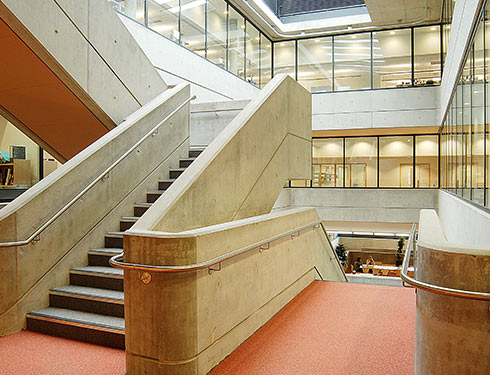
‘I like buildings. I like architecture. I like design. But what I really like is problem-solving.’ As an engineer’s opening gambit, it’s a strong one. ‘I’m not a designer in the truest sense. I don’t instigate design, I interpret someone else’s,’ Peter explains. ‘I have the ability to appreciate where an architect is trying to get to, and to understand where they are coming from. I’m always interpreting.’
Peter was always good at maths and physics, and after studying engineering, computer science and politics at university, he worked with one of the largest engineering practices in his native Australia. His projects in those early years included stadia infrastructure for the impending Sydney Olympics in 2000, including work on the roof of the main stadium.
After a time spent in Hong Kong working on both colonial architecture and tall buildings of the city’s renowned skyline, Peter relocated to the UK. He brought his ‘can-do’ approach to his work with him. ‘I always say to my team, say yes and we’ll figure out how to do it later! I hate it when people are negative about possibilities. Whatever an architect needs, we can do it,’ Peter says. ‘You’ve got a challenge; we can solve it. It starts with a yes.’
Even though Peter’s father is a civil engineer who has worked on big infrastructure projects like bridges and motorways, and despite Peter’s own early introduction to Olympic-scaled construction, he doesn’t have a singular favourite type of project. ‘My Dad’s work led me to be aware of buildings, and there are many that I admire greatly, but for me it’s much more about the architect than the type of architecture,’ he points out. ‘I really enjoy working with my architects. The best ones have a really clear idea, they are organised. I can talk to them about how to produce a building rather than what there is at the end.’ When pressed on what his favourite building might be, he relents. ‘Anything Niall McLaughlin does!’
Peter’s admiration for the architects he works with is reciprocated, as evidenced by the many long relationships he’s developed and the long list of repeat commissions he has worked on over more than two decades at Price & Myers. He prides himself on his friendly approach and the care he invests in his work. ‘Our collaborators see us as a helpful and friendly group of people to work with. We don’t just design once and say there you go. We will iterate and reiterate and go the extra mile.’
As a Partner at the practice, that openness and approachability is part of the culture Peter has helped to build. ‘People care about the work and about making people comfortable. If I didn’t already work here, I’d say that’s a place I’d like to work.’ When asked about his leadership style, Peter is reluctant to acknowledge that he has one, preferring to emphasise a team ethic where the buck stops with him. ‘I will drop everything to respond to a question – from my client, my team, or my collaborators. That’s my role,’ he asserts. ‘By the time a question gets to me, it’s a judgement call. I draw on my experience and my knowledge to make that call. I’m not ‘top-down’ - I’ll consult – but I can’t be everyone’s friend. I have to make the right call.’
A significant portion of Peter’s portfolio features multi-residential development and estate regeneration, often working with big developers and housing associations. It’s work he finds particularly satisfying. ‘Our approach adds to our reputation and the developers know us that way too,’ he notes. ‘They respect us for being willing to solve problems rather than just give them the easiest answer.’ Peter enjoys when he can take action to reduce the impact of a project on the climate, as well as saving his clients money. ‘We are forced to think more creatively. Reducing carbon also allows us to help protect our clients’ capital. Trying to use less concrete results in a better answer that’s cheaper and with lower embodied carbon. We design in such a way that allows us to say - we can save you 50 cubic metres of concrete if you let us put a pile there.’
Designing buildings with lower embodied carbon is central to Peter’s philosophy and he’s pleased that it’s a discussion that is increasing in prominence. ‘It’s our job to talk about it. Sometimes we are the only ones talking about it, but now people are starting to listen.’ He doesn’t like to look too far into the future – ‘to be too certain of the future can lead us down the wrong path’ – but he sees the coming together of a low-carbon agenda and an increase in technology-led efficiency as a promising portent for a greener world. ‘We have to use the tools that we have and the tools that we develop to our advantage. It’s very big with our graduate engineers and it’s great that young people are leading.’
Leadership is a responsibility that Peter wears lightly. Having worked around the world, across a substantial range of building types and scales, he’s built an impressive body of work with an impressive array of collaborators. He enjoys a reputation for being very approachable – ‘we all are at P&M’ – and someone who runs great projects. As he says himself, ‘I try hard to not be anything other than be me.’ One last question, is it ‘Peter’ or is it ‘Pete’?
‘Pete’s fine.’











